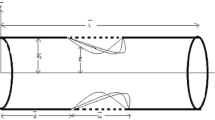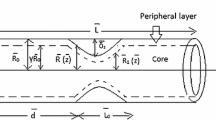Abstract
The present paper concerns a mathematical model for steady flow of blood through tapered stenosed arteries with peripheral plasma layer near the wall. The model consists of a core region of suspension of all the erythrocytes assumed to be a couple stress fluid and a peripheral layer of plasma as a Newtonian fluid. A non-zero couple stress boundary condition at the interface is introduced. The values of velocity, wall shear stress and the flow resistance with respect to the non-zero couple stress condition at the interface for normal blood and diseased [polycythemia, plasmal cell dyscrasias and HBSS (sickle cell)] blood are computed. It is observed that the introduction of the non-zero couple stress boundary condition at the interface helps to increase the velocity and significantly reduces the resistive impedance which, in turn, improves or normalizes the blood flow in diseased state. This information of blood flow could be useful for the development of new diagnosis tools and medicines for many diseases.













Similar content being viewed by others
References
Chaturani, P., Ponnalagarsamy, R.: Pulsatile flow of Casson’s fluid through stenosed arteries with applications to blood flow. Biorheology 23, 499–511 (1986)
Young, D.F.: Effects of a time-dependent stenosis on flow through a tube. J. Eng. Ind. Trans. AMSE 90, 248–254 (1968)
Shukla, J.B., Parihar, R.S., Gupta, S.P.: Biorhelogical aspects of blood flow through artery with mild stenosis: effects of peripheral layer. Biorheology 17, 403–410 (1980a)
Ponalagusamy, R.: Mathematical analysis on effect of non-Newtonian behavior of blood on optimal geometry of microvascular bifurcation system. J. Frankl. Inst. 349, 2861–2874 (2012)
Chaturani, P., Ponnalagusamy, R.: A study of non-Newtonian aspects of blood flow through stenosed arteries and its applications in arterial diseases. Biorheology 22, 521–531 (1985)
Deshpamde, M.D., Giddens, D.P., Mabon, R.F.: Steady laminar flow through modeled vascular stenosis. J. Biomech. 9, 65–174 (1979)
Forrester, J.H., Young, D.F.: Flow through a converging–diverging tube and its implications in occlusive vascular diseases. J. Biomech. 3, 297–305 (1970)
Macdonald, D.A.: On steady flow through modeled vascular stenosis. J. Biomech. 12, 13–20 (1979)
Shukla, J.B., Parihar, R.S., Gupta, S.P.: Effects of peripheral layer viscosity on blood flow through the artery with mild stenosis. Bull. Math. Biol. 42, 797–805 (1980b)
Ponalagusamy, R.: Blood flow through an artery with mild stenosis: a two-layered model, different shapes of stenoses and slip velocity at the wall. J. Appl. Sci. 7, 1071–1077 (2007)
Ponalagusamy, R., Tamil Selvi, R.: A study on two-fluid model (Casson–Newtonian) for blood flow through an arterial stenosis: axially variable slip velocity at the wall. J. Frankl. Inst. 348, 2308–2321 (2011)
Ponalagusamy, R., Tamil Selvi, R.: Blood flow in stenosed arteries with radially variable viscosity, peripheral plasma layer thickness and magnetic field. Meccanica 48, 2427–2438 (2013)
Stokes, V.K.: Couple stresses in fluids. Phys. Fluids 9, 1710–1717 (1966)
Valanis, K.C., Sun, C.T.: Poiseuille flow of a fluid with couple stress with application to blood flow. Biorheology 6, 85–95 (1969)
Bugliarello, G., Sevilla, J.: Velocity distribution and other characteristics of steady and pulsatile blood flow in fine glass tubes. Biorhelogy l7, 85–107 (1970)
Bugliarello, G., Hayden, J.W.: Detailed characteristics of the flow of blood in vitro. Trans. Soc. Rheol. 7, 209–230 (1963)
Chaturani, P., Kaloni, P.N.: Two -layered poiseuille flow model for blood flow through arteries of small diameter and arterioles. Biorheology 13, 243–250 (1976)
Chaturani, P., Ponalagusamy, R.: A two-layered model for blood flow through stenosed arteries. In: Procedings of \(11^{{\rm th}}\) National Conference on Fluid Mechanics and Fluid Power, B.H.E.L (R&D), Hydrabad, India, pp. 16–22 (1982)
Ponalagusamy, R.: Blood flow through stenosed tube. Ph.D. thesis, IIT, Bombay, India (1986)
Srivastava, V.P., Srivastava, R.: Particulate suspension blood flow through a narrow catheterized artery. Comput. Math. Appl. 58, 227–238 (2009)
Srivastava, V.P., Rastogi, R., Vishnoi, R.: A two-layered suspension blood flow through an overlapping stenosis. Comput. Math. Appl. 60, 432–441 (2010)
Srivastava, V.P., Rastogi, R.: Blood flow through a stenosed catheterized artery: effects of hematocrit and stenosis shape. Comput. Math. Appl. 59, 1377–1385 (2010)
Srivastava, V.P., Saxena, M.: Two-layered model of Casson fluid flow through stenotic blood vessels: applications to cardiovascular system. J. Biomech. 27, 921–928 (1994)
Rathod, V.P., Tanveer, S., Rani, I.S., Rajput, G.G.: Steady blood flow with periodic body acceleration and magnetic field. Acta Ciencia Indica XXXI M, 41–46 (2005)
Mathur, P., Jain, S.: Pulsatile flow of blood through a stenosed tube: effect of periodic body acceleration and a magnetic field. J. Biorheol. 25, 71–77 (2011)
Sinha, P., Singh, C.: Effects of couple stresses on the blood flow through an artery with mild stenosis. Biorheology 21, 303–310 (1984)
Pralhad, R.N., Schultz, D.H.: Modeling of arterial stenosis and its applications to blood diseases. Math. Biosci. 190, 203–220 (2004)
Srinivasacharya, D., Srikanth, D.: Effect of couple stresses on the pulsatile flow through a constricted annulus. C. R. Mecanique 336, 820–827 (2008)
Srivastava, V.P.: Flow of a couple stress fluid representing blood through stenotic vessels with a peripheral layer. Indian J. Pure Appl. Math. 34, 1727–1740 (2003)
Farooq, M., Rahim, M.T., Islam, S., Siddiqui, A.M.: Steady Poiseuille flow and heat transfer of couple stress fluids between two parallel inclined plates with variable viscosity. J. Assoc. Arab Univ. Basic Appl. Sci. 14, 9–18 (2013)
Chippa, S.P., Sarangi, M.: Elastohydrodynamically lubricated finite line contact with couple stress fluids. Tribol. Int. 67, 11–20 (2013)
Devakar, M., Sreenivasu, D., Shankar, B.: Analytical solutions of couple stress fluid flows with slip boundary conditions. Alex. Eng. J. 53, 723–730 (2014)
Srikanth, D., Ramana Reddy, J.V., Jain, Shubha, Kale, Anup: Unsteady polar fluid model of blood flow through tapered \(\omega \) x-shape stenosed artery: effects of catheter and velocity slip. Ain Shams Eng. J. 6, 1093–1104 (2015)
Chaturani, P., Upadhya, V.S., Mahajan, S.P.: A two-fluid model for blood flow through small diameter tubes with non-zero couple stress boundary condition at interface. Biorheology 18, 245–253 (1981)
Chaturani, P., Mahajan, S.P.: Poiseuille flow of micropolar fluid with non-zero couple stress at boundary with applications to blood flow. Biorheology 19, 507–518 (1982)
Ponalagusamy,R.: Pulsatile flow of Herschel–Bulkley fluid in tapered blood vessels. In: Proceedings of the 2013 International Conference on Scientific Computing (CSC 2013), WorldComp’13, Lasvegas, USA, July 22–25, 2013, pp. 67–73. ISBN:1-60132-238-0 (2013)
Mekheimer, Khs, EI Kot, M.A.: The micropolar fluid model for blood flow through a tapered artery with a stenosis. Acta Mech. Sin. 24, 637–644 (2008)
Merchut, M.P., Gupta, S.R., Naheedy, M.H.: The role of retinal occlusion and carotid artery stenosis. Stroke 19, 1239–1242 (1988)
Palmer, A.H., Defeyter, I.R., Vandenbogaerde, J.F.: Renal arterial stenosis as a cause of high output cardiac failure. Int. J. Cardiol. 22, 404–406 (1989)
Chien, S.: Hemorheology in clinical medicine. Clin. Hemorheol. 2, 137–143 (1982)
Author information
Authors and Affiliations
Corresponding author
Rights and permissions
About this article
Cite this article
Ponalagusamy, R. Two-Fluid Model for Blood Flow Through a Tapered Arterial Stenosis: Effect of Non-zero Couple Stress Boundary Condition at the Interface. Int. J. Appl. Comput. Math 3, 807–824 (2017). https://doi.org/10.1007/s40819-016-0133-3
Published:
Issue Date:
DOI: https://doi.org/10.1007/s40819-016-0133-3




